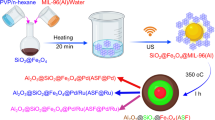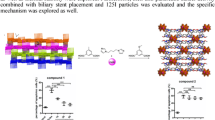Abstract
Two new mixed ligand-based compounds, namely [Zn(3,4’-bpdc)(bpp)]n·2n(H2O) (1) and [Co2(3,3’-bpdc)2(4,4’-dpp)]n·2n(H2O) (2) (3,4’-H2bpdc = 3,4’-biphenyldicarboxylic acid, bpp is 1,3-bis(4-pyridyl)propane, 3,3’-H2bpdc = 3,3’-biphenyldicarboxylic acid, 4,4’-dpp = 1,4-bis(pyridine-4-ylmethyyl)piperazine), have been hydrothermally synthesized and characterized via the PXRD, EA, as well as the diffraction analyses of single-crystal X-ray. Furthermore, compound 1’s luminescent performance and compound 2’s photocatalytic performance were also explored. Their enhancement activity on prostate cancer combined with 125I radioactive particle placement was evaluated, and the related mechanism was explored at the same time. Firstly, the ELISA was used to measure the inhibitory activity of the new compounds on the serum IGF-1. In addition to this, the activation of the VEGF signaling pathway was also determined with real-time RT-PCR.







Similar content being viewed by others
Data Availability
Selected bond lengths (Å) and angles (°) for compounds 1–2 (Table S1); the PXRD patterns (a) for compound 1 and (b) for compound 2 (Fig. S1); the SEM diagrams for compound 1 (up) and for compound 2 (down) (Fig. S2), the information can be found in supporting information file.
References
Komura K, Sweeney CJ, Inamoto T, Ibuki N, Azuma H, Kantoff PW (2018) Current treatment strategies for advanced prostate cancer. Int J Urol 25:220–231
Chang AJ, Autio KA, Roach M, Scher HI (2014) High-risk prostate cancer-classification and therapy. Nat Rev Clin Oncol 11:308–323
Ghasempour H, Wang KY, Powell JA, Zarekarizi F, Lv XL, Morsali A, Zhou HC (2021) Metal-organic frameworks based on multicarboxylate linkers. Coord Chem Rev 426:213542
Ghayour H, Abdellahi M, Ozada N, Jabbrzare S, Khandan A (2017) Hyperthermia application of zinc doped nickel ferrite nanoparticles. J Phys Chem Solids 111:464–472
Ghayour H, Abdellahi M, Nejad MG, Khandan A, Saber-Samandari S (2018) Study of the effect of the Zn2+ content on the anisotropy and specific absorption rate of the cobalt ferrite: the application of Co1−xZnxFe2O4 ferrite for magnetic hyperthermia. J Aust Ceram Soc 54:223–230
Raisi A, Asefnejad A, Shahali M (2022) A soft tissue fabricated using a freeze-drying technique with carboxymethyl chitosan and nanoparticles for promoting effects on wound healing. J Nanoanalysis 7:262–274
Foroutan S, Hashemian M, Khosravi M, Nejad MG, Asefnejad A, Saber-Samandari S, Khandan A (2021) A porous sodium alginate-CaSiO3 polymer reinforced with graphene nanosheet: fabrication and optimality analysis. Fibers Polym 22:540–549
Karimi M, Asefnejad A, Aflaki D, Surendar A, Baharifar H, Saber-Samandari S, Khandan A, Khan A, Toghraie D (2021) Fabrication of shapeless scaffolds reinforced with baghdadite-magnetite nanoparticles using a 3D printer and freeze-drying technique. J Mater Res Technol 14:3070–3079
Raisi A, Asefnejad A, Shahali M (2020) Preparation, characterization, and antibacterial studies of N, O-carboxymethyl chitosan as a wound dressing for bedsore application. Arch Trauma Res 20:128–130
Jamnezhad S, Asefnejad A, Motififard M (2020) Development and investigation of novel alginate-hyaluronic acid bone fillers using freeze drying technique for orthopedic field. Nanomed Res J 5:306–315
Tang YH, Wu X, Wang F, Zhang J (2017) Synthesis of zeolite-like metal-organic frameworks via a dual-ligand strategy. CrystEngComm 19:2549–2552
Cao XY, Zhang J, Li ZJ, Cheng JK, Yao YG (2007) Scorpion-shaped carboxylate ligand tailored molecular square, bilayer, self-threading and (3,6)-connected nets. CrystEngComm 9:806–814
He YP, Tan YX, Zhang J (2013) Tuning a layer to a pillared-layer metal–organic framework for adsorption and separation of light hydrocarbons. Chem Commun 49:11323–11325
Yang MX, Chen LJ, Ma R, Cai JN, Shi YD, Lin S (2019) Three 3D Co(II) cluster-based MOFs constructed from polycarboxylate acids and bis(imidazole) ligands and their derivatives: magnetic properties and catalytic performance for the ORR. Dalton Trans 48:13369–13377
Yang JX, Qin YY, Ye RP, Zhang X, Yao YG (2016) Employing mixed-ligand strategy to construct a series of luminescent Cd(II) compounds with structural diversities. CrystEngComm 18:8309–8320
Su YQ, Li XX, Li XJ, Pan H, Wang RH (2015) Effects of hydroxy substituents on Cu(II) coordination polymers based on 5-hydroxyisophthalate derivatives and 1,4-bis(2-methylimidazol-1-yl) benzene. CrystEngComm 17:4883–4894
Yang GB, Sun ZH (2013) Tuning the structural topologies of two luminescent metal-organic frameworks through altering auxiliarly ligand. Inorg Chem Commun 29:94–96
Li X, Yu ZJ, Guan T, Li X, Ma G, Guo X (2015) Substituent effects of isophthalate derivatives on the construction of zinc(II) coordination polymers incorporating flexible bis(imidazolyl) ligands. Cryst Growth Des 15:278–290
Zhang J, Chew E, Chen S, Pham JTH, Bu X (2008) Three-dimensional homochiral transition-Metal camphorate architectures directed by a flexible auxiliary ligand. Inorg Chem 47:3495–3497
Sheldrick GM (2015) Crystal structure refinement with SHELXL. Acta Crystallogr Sect C Struct Chem 71:3–8
van der Sluis P, Spek AL (1990) BYPASS: an effective method for the refinement of crystal structures containing disordered solvent regions. Acta Crystallogr Sect A Crystallogr 46:194–201
Sun D, Han LL, Yuan S, Deng YK, Xu MZ, Sun DF (2013) Four new Cd(II) coordination polymers with mixed multidentate N-donors and biphenyl-based polycarboxylate ligands: syntheses, structures, and photoluminescent properties. Cryst Growth Des 13:377–385
Li JX, Qin ZB, Li YH, Cui GH (2018) Visible-light-driven photocatalyst for the degradation of methylene blue over a 3D cobalt(II)-4,4’-oxybis(benzoate) framework. Inorg Chem Commun 90:112–114
Author information
Authors and Affiliations
Corresponding author
Ethics declarations
Conflict of interest
The author(s) declare(s) that there is no conflict of interest regarding the publication of this paper.
Additional information
Publisher's Note
Springer Nature remains neutral with regard to jurisdictional claims in published maps and institutional affiliations.
Supplementary Information
Below is the link to the electronic supplementary material.
Rights and permissions
About this article
Cite this article
Du, P., Yuan, X., Sun, Z. et al. Two coordination polymers: luminescent, photocatalytic property and enhancement activity on prostate cancer combined with 125I radioactive particle placement. Polym. Bull. 80, 883–894 (2023). https://doi.org/10.1007/s00289-021-04055-4
Received:
Revised:
Accepted:
Published:
Issue Date:
DOI: https://doi.org/10.1007/s00289-021-04055-4




